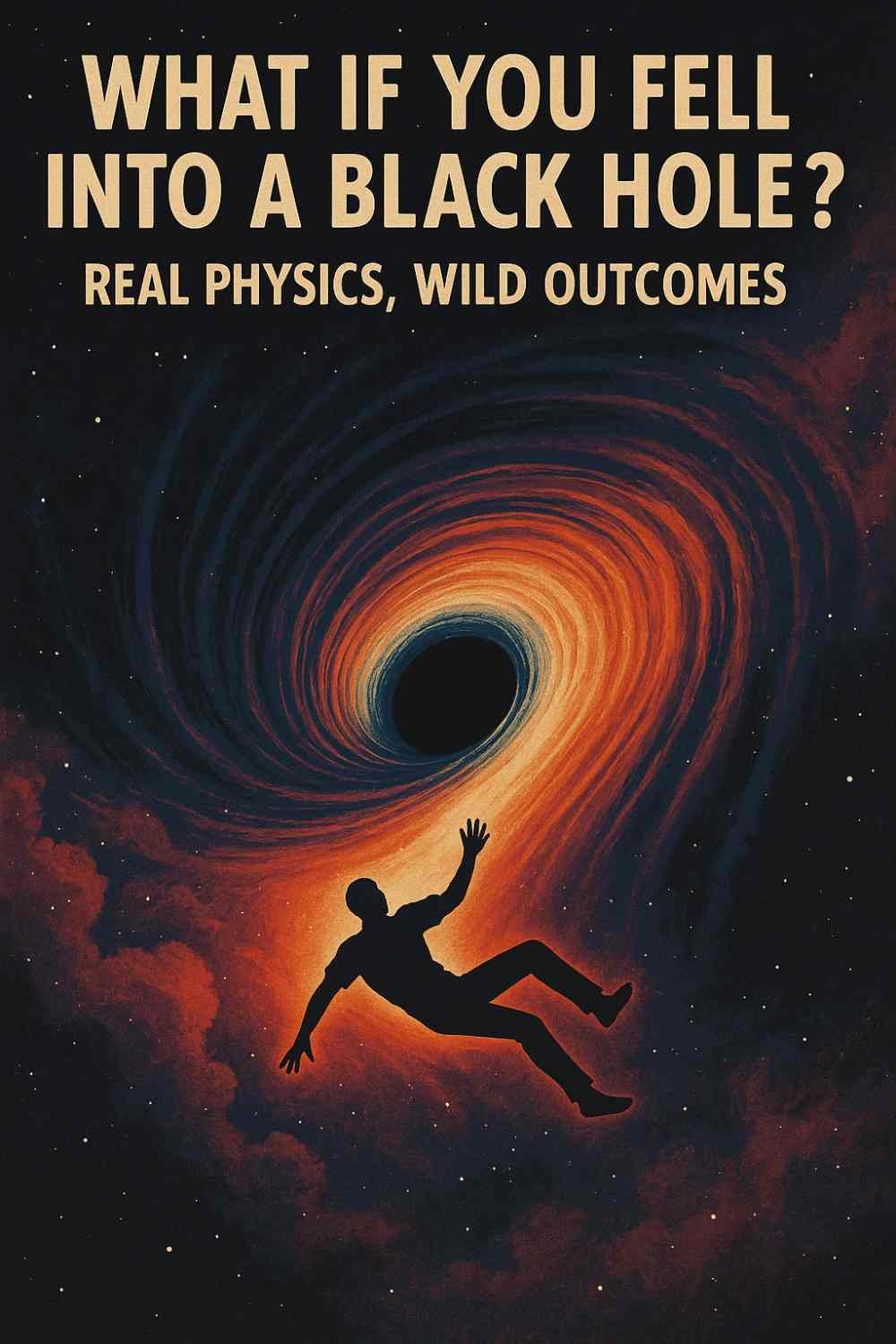What If You Fell Into a Black Hole? Real Physics, Wild Outcomes
Let’s drop the sci-fi theatrics for a minute and ask the blunt question: if you—the actual you—fell toward a black hole, what would really happen? No cinematic wormholes on cue, no last-second tractor beam. Just gravity, radiation, and the weird rules of spacetime.
This is a guide that keeps the awe, ditches the fluff, and leans on what modern physics actually says. Buckle up.
First, What You’re Aiming At 🌌
A black hole isn’t a cosmic vacuum cleaner. It’s a place where gravity has crushed matter so tightly that escape becomes impossible past a certain boundary: the event horizon. Outside that horizon, light can still escape. Inside, every path—no matter what you do—points inward.
Two flavors matter for your odds:
Stellar-mass black holes (a few to a few dozen Suns): tiny horizons, brutal tidal forces.
Supermassive black holes (millions to billions of Suns, like the ones at galaxy centers): enormous horizons, gentler tides at the edge.
Why that matters will hit you—literally—when tides start stretching you like taffy.
The Fall: What You Feel vs. What Others See ⏱️
Your experience (proper time): You fall, you cross the event horizon in finite time, and you don’t feel a magical “wall.” If the black hole is supermassive, the tides at the horizon can be mild enough that your body doesn’t rip apart immediately.
What a distant observer sees: You appear to slow down as you approach the horizon, your light redshifts to dimmer, redder wavelengths, and you seem to “freeze” just outside. That’s not your experience; it’s a perspective effect from general relativity.
Both are true—depending on where you sit.
Tidal Forces: The Spaghettification Problem 🍝
Gravity pulls harder on the part of you closer to the black hole than the part farther away. That difference is the tidal force.
Stellar-mass case: The event horizon is so tight that the tidal difference near (and even outside) the horizon is devastating. You’d be stretched, bones and all, well before you cross.
Supermassive case: The horizon can span millions of kilometers. The tidal gradient right at the horizon can be gentle. You could cross with your body intact—for a while.
“Spaghettification” isn’t cartoon physics. It’s the math of differential gravity, and it decides whether you’re pulled apart early or late.
The Accretion Gauntlet: Heat, Light, and Death ☄️
Movies love the quiet, matte-black sphere. Reality? Many black holes wear a glowing accretion disk: superheated gas spiraling in, colliding and radiating X-rays and gamma rays.
If you plunge through an active disk, you face extreme radiation and high-speed particle impacts. Exposure like that sterilizes biology fast.
If you fall into a relatively quiet, underfed black hole, the space around the horizon could be surprisingly dark and calm.
So your odds aren’t just about gravity—they’re about the neighborhood.
Crossing the Horizon: Does Anything Special Happen? 🚪
In classical general relativity: no drama at the horizon for a large black hole. No bump, no thud, no new physics alarm going off. Locally, free fall feels like floating.
But let’s be honest: quantum physics muddies the water. The black hole information paradox sparked ideas like firewalls—hypothetical high-energy curtains at the horizon that would fry you instantly. Is that real? Unknown. The field is debating. If nature installs a firewall, the story ends early. If not, you float on—for now.
Inside: Where “Toward the Center” Becomes “Toward Your Fate” 🧭
Once you’re inside, every path forward pushes you inward. You can fire rockets, spin, pray—it doesn’t matter. Spacetime is drawn like a funnel; “future” is the singularity.
For a non-rotating (Schwarzschild) black hole: the math says your journey ends at a point of infinite curvature—the singularity—within a finite amount of your own time.
For a rotating (Kerr) black hole: the singularity becomes a ring, and the interior geometry grows complicated, with inner horizons and theoretical “exits.” Tempting tales of wormholes show up here. Problem: those paths appear unstable in realistic conditions. The inner horizon likely floods with energy (blue-shifted light), turning any “shortcut” into a physics demolition zone.
So, best you keep expectations grounded: inside the horizon, your future is short and one-way.
Time Tricks: Would You See the End of the Universe? 🕰️
Classic coffee-shop question. Here’s the sober take:
You do get a hefty dose of gravitational time dilation. Outside clocks tick faster compared to yours as you fall deeper.
But you don’t get infinite time to watch the cosmos. Your proper time to the singularity is limited, especially in stellar-mass holes. Even in the supermassive case, you can’t stream aeons of the universe’s future before the end.
You can witness a speed-up of events outside, but not the entire future history of everything.
Could You Survive to Send a Message Back? 📡
You can send signals outward right up until you cross the horizon. After that: no. Not even light escapes. If your gear is intact near the edge of a quiet, supermassive black hole, you might get a final radio beacon out. Once you pass the horizon, your messages are for the singularity’s eyes only.
What About Hawking Radiation—Does the Hole Evaporate Under You? ☄️
Hawking radiation exists in our best semiclassical picture, but for big black holes the temperature is unbelievably cold. A supermassive black hole’s Hawking glow is gentler than the cosmic microwave background. It won’t boil you off. Evaporation happens on timescales so absurdly long that it’s irrelevant to a falling human lifetime.
Myth vs. Reality 🧪
📖 Myth: You’d get sucked in from light-years away.
Reality: Gravity obeys the inverse-square law. At large distances, you feel what you’d feel from any object of the same mass. You only get “sucked in” if you wander too close—like any orbit gone wrong.
📖 Myth: You’d see yourself freeze at the horizon.
Reality: That’s the distant observer’s view. Your own watch ticks normally; you cross and notice nothing special (firewalls aside).
📖 Myth: All black holes are raging X-ray beacons.
Reality: Many are quiet unless fed. Accretion sets the light show.
📖 Myth: Inside, you can fly around and escape later.
Reality: Inside the horizon, “later” means “closer to the singularity.” Escape is not on the menu.
Supermassive vs. Stellar-Mass: Your Two Main Timelines 🧭
Stellar-mass black hole
Approach: intense radiation likely if there’s a hot disk.
Horizon: tidal forces may shred you before or at the horizon.
Inside: you don’t last long.
Supermassive black hole
Approach: radiation danger varies—quiet holes are less hostile.
Horizon: you could cross intact; no local fireworks.
Inside: you have minutes to hours (estimate) of proper time. The end is still the singularity.
Either way, the destination is the same. The scenery on the way down changes with mass and environment.
The Kerr Wildcard: Spin, Jets, and Interior Weirdness 🌀
Most real black holes spin. Spin does three big things:
Frames drag: space itself swirls. You get carried along.
Horizon size shifts: spinning holes have a smaller event horizon than non-spinning ones of the same mass.
Relativistic jets: not from the hole itself (nothing leaves the horizon), but from the disk and magnetic fields. If you cross the disk near where jets are launched, you’re in hostile territory—particle accelerators on cosmic scales.
Inside, spin adds inner horizons and a ring singularity in the math, but once you factor in realistic disturbances, those structures likely become chaotic and destructive. Don’t plan a layover.
So…Could Anyone “Make It Through”? 🧭
Short answer: no—not in the “travel-through-and-pop-out-elsewhere” sense. Our best current physics says the interior funnels everything to a singularity. If quantum gravity softens that singularity into something survivable, we don’t know it yet.
The most generous scenario is a quiet, supermassive black hole giving you a graceful horizon crossing and a little time to think deep thoughts before the end.
Practical Curiosities—If You’re Morbidly Curious 💡
What kills you first? Depends on the hole. Tidal forces, radiation, or interior instabilities all compete.
Can you aim for minimal pain? Fall into a quiet, supermassive hole and avoid the accretion disk. You’ll still lose, just later.
Could your atoms escape? Not after the horizon. Your information becomes part of the hole. How that information is encoded is the famous paradox physicists wrestle with.
FAQ (Short, Sharp, Useful) ❓
Q: Do I notice crossing the horizon?
A: In classical GR, not really—if the hole is large and quiet. In speculative firewall models, yes, catastrophically.
Q: How long until the end once inside?
A: Finite and short in human terms. For stellar holes: very short. For supermassive: longer, but not long enough to finish a novel.
Q: Can I see future centuries outside while falling?
A: You’ll see time outside tick faster, but you don’t get infinite binge-watching before your clock runs out.
Q: Is Hawking radiation dangerous during the fall?
A: Not for large black holes. It’s feeble compared to everything else going on.
Why This Thought Experiment Matters 🚀
Black holes force us to face where our theories crackle. General relativity nails gravity on big scales; quantum mechanics rules the tiny and the energetic. At a horizon, they shake hands awkwardly and physics gets spicy. That tension drives new ideas, new observations, and better math. The universe uses black holes to grade our homework.
If you like testing your brain against cosmic puzzles, you’ll enjoy daily brain-teasers too. Try the Bing Homepage Quiz guide for a quick daily challenge, or browse the wider Bing Weekly Quiz hub when you want a broader mix. Curiosity is a muscle—work it.
Bottom Line 🧾
Outside the horizon, gravity behaves just like any other mass of the same size.
The event horizon is a one-way door.
Stellar-mass holes are lethal early; supermassive holes are deceptively gentle at the edge but still terminal.
Accretion environments can kill you before gravity gets the chance.
Inside, all roads lead inward. No exits. No messages out.
Hawking radiation won’t save or cook you on the way down.
The most honest answer to “what if I fall in?” is: you’d witness some unforgettable physics…for a little while.
Author

A seasoned Finance Head of a leading IT company in the United States, with over a decade of experience in corporate finance, strategic planning, and data-driven decision-making. Passionate about numbers and innovation, Ryan combines financial expertise with a deep understanding of the tech industry to drive sustainable growth and efficiency.

